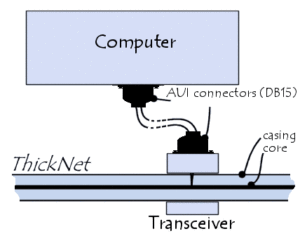In the early days of Ethernet, collisions on the network prevented its use in deterministic industrial applications. If two stations tried to transmit at the same time, a collision would result. The collision was detected and each station “backed off” a random time and tried again. This approach was fine for web browsing and email but prevented determinism. The advent of switched Ethernet networks did away will collisions allowing Ethernet to be applied in industrial automation where determinism was a must. In switched networks any node can transmit whenever it needs to without collisions.
Let’s look at some Ethernet history to see the path to switched Ethernet:
Thicknet
Thicknet, known formally as 10BASE5, was the earliest form of Ethernet. Called thicknet because the coaxial cable was stiff and thick. It used CSMA/CD (more on that later). The 10 in the formal name derives from the network speed, 10 Mbit/s.

Thinnet
Thicknet was naturally followed by thinnet (10BASE2). Also called cheapernet because thinner cables are less expensive than thicker ones. Also runs at 10 Mbit/s. Early industrial projects used this technology for non-time critical, non-deterministic communications, like among HMIs. Note: requires a terminating resistor at the terminus. Also used CSMA/CD.
Carrier Sense Multiple Access / Collision Detection
CSMA/CD (Carrier Sense Multiple Access / Collision Detection). Webopedia defines this well as
[A] set of rules determining how network devices respond when two devices attempt to use a data channel simultaneously (called a collision). Standard Ethernet networks use CSMA/CD to physically monitor the traffic on the line at participating stations. If no transmission is taking place at the time, the particular station can transmit. If two stations attempt to transmit simultaneously, this causes a collision, which is detected by all participating stations. After a random time interval, the stations that collided attempt to transmit again. If another collision occurs, the time intervals from which the random waiting time is selected are increased step by step. This is known as exponential back off.
CSMA/CD is a type of contention protocol. Networks using the CSMA/CD procedure are simple to implement but do not have deterministic transmission characteristics.
The last sentence reveals why early incarnations of Ethernet were not suitable for industrial automation – not deterministic. Injecting a random time before retransmitting is not conducive to determinism.
Switched Ethernet Networks.
Switched networks are very different from earlier versions. In fact, the creator of Ethernet, Robert Metcalfe, is reported to have said that people keep inventing entirely new networks and calling them Ethernet.
What we now call Ethernet no longer uses coax; we have 4-wire or 8-wire cables with twisted pairs, using RJ45 connectors (and sometimes M12 connectors in industry). It can run at 10Mbit/s but more commonly at 100Mbit/s with much faster speeds already standardized. Instead of one cable connecting all nodes as thicknet and thinnet did, one cable connects two and only two nodes.
No more non-deterministic shared medium of thicknet and thinnet. In switched networks nodes that pass through messages are Ethernet switches that direct an incoming message to the targeted destination based on the physical address (MAC address) of the source and destination. These Ethernet switches may be standalone devices whose only purpose is to switch… or the Ethernet switches may be built into automation devices.
This video provides insight into how a switched network works.
It was the arrival of switched Ethernet that allowed PI to base PROFINET on it. PROFINET over switched Ethernet is deterministic. PROFINET uses one more technique to achieve determinism: PROFINET uses the standard IEEE802.3 Ethernet frame parameter EtherType to direct PROFINET Real-Time (RT) messages from Ethernet to the PROFINET application. This skips the TCP/IP layers which add variable delays to messages passing through them.
PROFINET achieves determinism over switched Ethernet infrastructure using standard IEEE802.3 Ethernet.
Adapted from the PROFIblog post: Switched Ethernet Networks for PROFINET Determinism.
